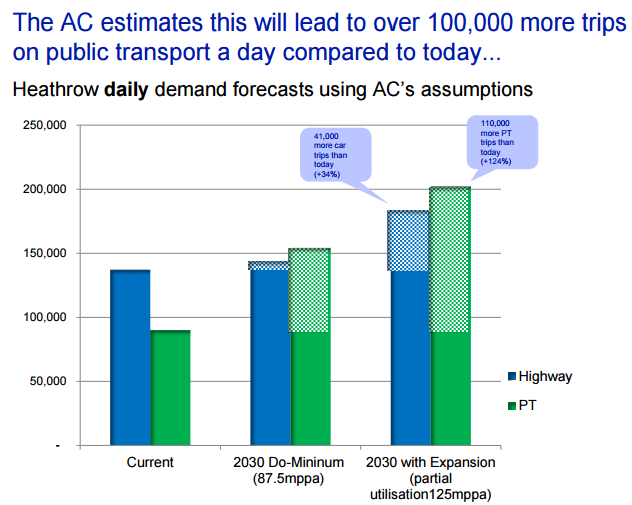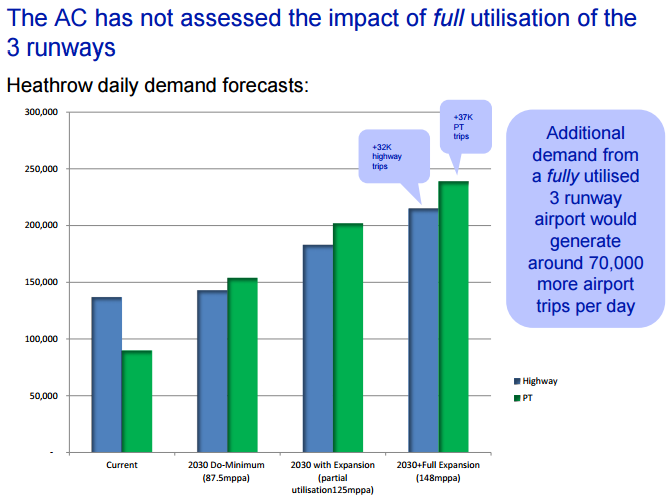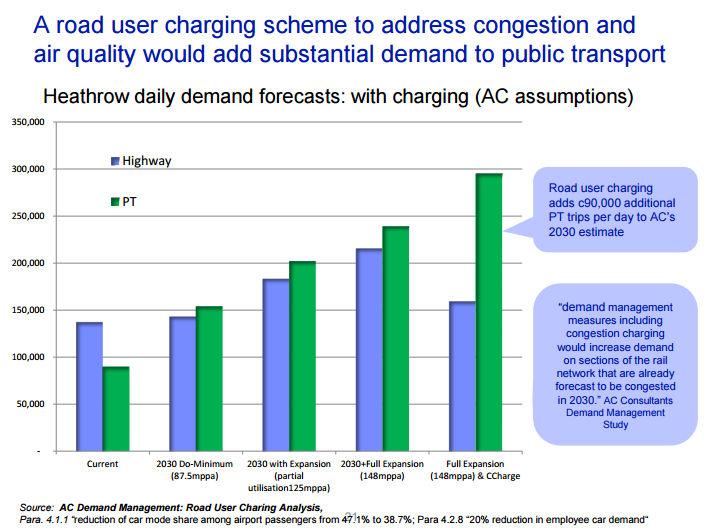TfL confirms extent to which Airports Commission underestimated Heathrow runway impact on surface access
Date added: 13 November, 2015
On 10th November, the GLA Transport Committee had a session looking at the implications for surface access – road, rail and Tube – if there was a 3rd Heathrow runway. There was a presentation by Richard De Cani (Transport for London’s Managing Director – Planning). The meeting was described as a “well mannered mugging” of the Airports Commission’s (AC) analysis of the situation. The AC did not assess the impact of a fully utilised 3rd runway, with 148 mppa; instead they only looked at the situation in 2030 with 125mppa. That might mean 70,000 more trips per day than estimated by the AC.They also did not take into account how recent employment forecasts will increase demand even further, or increased vehicles needed for expanded air freight capacity. TfL estimates it would cost between £15 and £20 billion to improve the transport infrastructure needed to get all passengers to and from Heathrow, with a 3rd runway. Unless this is spent, the road congestion and the rail congestion even by 2030 would be “some of the worst that we currently see in London.” It would “impact quite significantly on the whole performance of the transport network across west and south west London.” If there was a congestion charge, the impact on public transport would be even higher (perhaps 90,000 more trips per day than estimated by the AC).
.
https://t.co/xlNf6aw8xt
Heathrow third runway risks grinding London transport to a halt.
10 November 2015 (GLA press release)
Transport for London (TfL) has voiced major concerns around the Airports Commission’s Final Report and its assessment on the impact of a third runway at Heathrow on London’s road, rail and Tube networks.
According to TfL, the Airports Commission has not assessed the impact of a fully utilised third runway at Heathrow Airport or taken into account how recent employment forecasts will increase demand even further.
The London Assembly Transport Committee today heard that it would cost between £15 and £20 billion to improve the transport infrastructure needed to get all passengers to and from Heathrow Airport, if a third runway is built there. [By contrast, Heathrow says only £1 billion would be needed from the taxpayer for public transport].
Richard De Cani, Managing Director – Planning, Transport for London said at the meeting:
“The simple word would be congestion – congestion on the road network, congestion on the rail network of a scale that we havn’t seen. The level of crowding you would have on those rail corridors into central London would be some of the worst that we currently see in London and that’s based on 2030 demand, the year of opening. So it’s a level of crowding and congestion that we believe would start to impact quite significantly on the whole performance of the transport network across west and south west London.”
Valerie Shawcross CBE AM, Chair of the London Assembly Transport Committee said;
“Today we heard that there are clear discrepancies between the Airports Commission’s assessment of transport demand with TfL’s own analysis. For example, the Airports Commission has only planned for passenger demand up to 2030, and does not take into account transport needs with the airport at full capacity after expansion.
Before the Government makes its decision on airport expansion, there are big questions to be answered around what transport infrastructure is needed and who will pay for it. We can’t allow a bigger Heathrow to clog up London’s roads and public transport network.”
Notes for Editors:
1. Valerie Shawcross CBE AM, Chair of the Transport Committee, is available for interview – see contact details below.
2. Surface Transport Access to Heathrow Airport: Presentation to the Assembly Transport Committee, 10 November 2015 is attached below.
5. As well as investigating issues that matter to Londoners, the London Assembly acts as a check and a balance on the Mayor.
.
The presentation by Richard De Cani
Three slides from this copied below:
Blue bars are Highway trips. Green bars are Public Transport trips.
This slide shows the huge increase in trips associated with a Heathrow 3rd runway. These are the Airports Commission’s figures, but they only consider Heathrow by 2030 with partial use of the airport. They do not take the figures beyond, to where the airport would be fully utilised, with 148 million passengers per year.
Even with Heathrow only at 125 mppa, there would be 41,000 more car trips per day (an increase of 34% from the level today [or the “Do Minimum” scenario] ) and 110,000 more Public Transport trips per day (an increase of 124% from the level today).
In this slide, blue bars are “highway trips” and green bars are PT (Public Transport)
This shows with a fully utilised 3 runway airport, (148 mppa) the number of highway trips would be 32,000 more per day than the Airports Commission estimated with only 125 mppa.
It also shows that with a fully utilised 3 runway airport, (148 mppa) the number of public transport trips would be 37,000 more per day than the Airports Commission estimated with only 125 mppa.
The total extra number of trips per day, above the Airports Commission estimate, would be almost 70,000.
This slide shows that if, in order to meet air quality targets, Heathrow had to introduce a congestion charge – in order to reduce road traffic – it would have the effect of requiring about 90,000 more public transport trips per day.
This would put yet further strain on public transport, that is already going to be struggling to cope with demand from sources other than the airport, by 2030 – and beyond.
.
Heathrow expansion: An unusual well-mannered mugging
By Tom Edwards (Transport correspondent, BBC)
10 November 2015
TfL officials estimated it would cost £15bn to £20bn in investment to build the new rail links required
Not many were listening or watching, but in City Hall Transport for London (TfL) officials piled into the Aviation Commission’s report on Heathrow on Tuesday.
This was an unusual departure for TfL; it doesn’t normally operate like this. This was a methodical mugging.
It told the Transport Committee of the London Assembly the Aviation Commission’s assessment was “substantially underestimating the impact of the third runway”.
The criticism went further. TfL says the Aviation Commission did not use the maximum capacity of the runway in its modelling. So instead of 385,000 extra trips per day on the transport network, there could be 450,000.
It said the modelling didn’t take into account freight and those trucks would have a huge impact on surrounding roads.
Crucially, the officials also estimated it would cost £15bn to £20bn in investment to build the new rail links required.
And the third runway could create “congestion on road and the rail network and overcrowding on a level we haven’t seen”.
The sentiments may not be new from TfL; some have implied the officials there are just doing the mayor’s bidding – but if they’re to be believed. the figures certainly show you the impact a third runway could have on surrounding transport infrastructure.
Update: Heathrow airport has been in touch: “Heathrow’s expansion will come with a step-change in rail access to the airport. With new rail lines to the north, south, east and west, Heathrow can increase the number of passengers taking public transport, and ensure that even with expansion, there is no more airport-related traffic compared to today.
“We are confident in our plans because we already have an outstanding record in increasing the use of public transport to get to the airport and encouraging people to shift out of their cars. Over the last 20 years, our passenger numbers have risen by almost 80% but airport related traffic has remained static.”
http://www.bbc.co.uk/news/uk-england-london-34779210
Posted: Friday, November 13th, 2015. Filed in Air Quality, News about Airports, Recent News.







